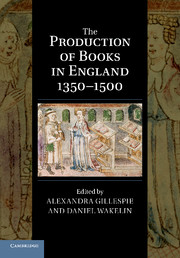Book contents
- Frontmatter
- Contents
- List of illustrations
- List of contributors
- Foreword
- Acknowledgements
- List of abbreviations
- Introduction
- 1 Materials
- 2 Writing the words
- 3 Mapping the words
- 4 Designing the page
- 5 Decorating and illustrating the page
- 6 Compiling the book
- 7 Bookbinding
- 8 Commercial organization and economic innovation
- 9 Vernacular literary manuscripts and their scribes
- 10 Book production outside commercial contexts
- 11 Censorship
- 12 Books beyond England
- 13 English books and the continent
- Afterword: the book in culture
- Bibliography
- Index of manuscripts
- General index
Introduction
Published online by Cambridge University Press: 05 May 2014
- Frontmatter
- Contents
- List of illustrations
- List of contributors
- Foreword
- Acknowledgements
- List of abbreviations
- Introduction
- 1 Materials
- 2 Writing the words
- 3 Mapping the words
- 4 Designing the page
- 5 Decorating and illustrating the page
- 6 Compiling the book
- 7 Bookbinding
- 8 Commercial organization and economic innovation
- 9 Vernacular literary manuscripts and their scribes
- 10 Book production outside commercial contexts
- 11 Censorship
- 12 Books beyond England
- 13 English books and the continent
- Afterword: the book in culture
- Bibliography
- Index of manuscripts
- General index
Summary
Some time in the mid fifteenth century, an illustrator – perhaps the London stationer-limner William Abell – was commissioned to illustrate BL, MS Cotton Tiberius A.vii, a copy of an English translation of Guillaume de Guileville's Pilgrimage of the Life of Man, sometimes ascribed to John Lydgate. One of the hundreds of unframed, pen-drawn miniatures that the limner produced appears on the cover of this book and is reproduced again here (Figure 0.1). Lady Hagiography, who has led the pilgrim-narrator on his wanderings through the poem, leads him and Lady Lesson behind him into a room filled with books: Lady Hagiography stands between the shelves and gestures to all the tomes of wisdom the pilgrim has yet to acquire.
The image has proved an evocative one for students of literary culture in the fourteenth and fifteenth centuries, and of the manuscripts which were that culture's essential tools. In 1942, Laura Hibbard Loomis took up the argument of earlier commentators and described Lady Hagiography's environs as a bookshop. Loomis made this a proof of her argument that in the decades before Geoffrey Chaucer established England's vernacular canon, the production of books was organized out of shops. The wares they produced included the vernacular books that were models for Chaucer's work, such as the 1330s Auchinleck manuscript of English romances in which Loomis was especially interested. In her discussions of this manuscript and England's fourteenth-century book ‘shops’ generally, Loomis posed some still important, still current questions.
- Type
- Chapter
- Information
- The Production of Books in England 1350–1500 , pp. 1 - 11Publisher: Cambridge University PressPrint publication year: 2011
- 1
- Cited by



